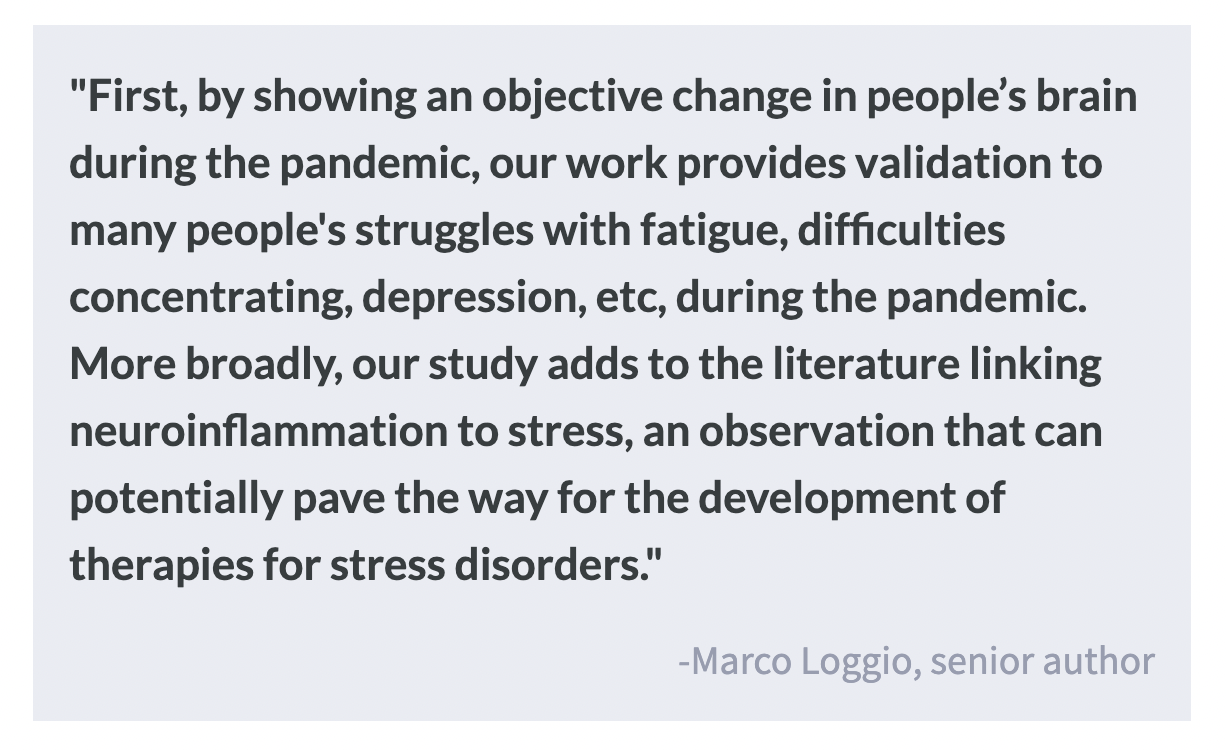The Effect of the COVID-19 Pandemic on Brain Inflammation
Post by Megan McCullough
The takeaway
Increased levels of biomarkers associated with neuroinflammation were observed in individuals studied after the beginning of the COVID-19 pandemic, but who had not experienced an infection of Sars-Cov-2.
What's the science?
The COVID-19 pandemic has had far-reaching effects on individuals who have experienced the societal impacts of stay-at-home measures meant to curb the spread of the virus. Previous studies have found an increase in reports of symptoms associated with psychological distress such as brain fog and fatigue since the onset of the pandemic. These psychological symptoms, as observed in various conditions such as fibromyalgia or chronic fatigue syndrome, have been previously linked to neuroinflammation. The effects the pandemic has had on the brain health of individuals who have not been infected with the virus are not well understood. This week in Brain, Behavior, and Immunity, Brusaferri and colleagues aimed to study the effects of the societal impacts of the COVID-19 pandemic on brain health by examining markers of inflammation in the brain.
How did they do it?
The authors conducted brain imaging on healthy participants studied after the pandemic onset and compared it to data from brain scans on healthy individuals conducted before the pandemic. Positron Emission Tomography and Magnetic Resonance imaging were used to study levels of the 18 kDa translocator protein (TSPO) and myoinositol (mIns). These biomarkers are indicative of an increase in activation of brain glial cells, a response indicative of neuroinflammation. The authors then looked at the link between these neuroinflammatory markers and behavior by administering a questionnaire that assessed impacts of the pandemic on the participants. Levels of TSPO and mIns were then compared between individuals in the pre-pandemic and the post-pandemic groups.
What did they find?
The authors found that participants in the Pandemic group had higher levels of the radiotracer that binds to TSPO in all the studied brain regions compared to participants in the Pre-Pandemic group, even after controlling for a series of factors (including age, vaccination status, etc). The individuals in the Pandemic group also had elevated levels of mINs in the thalamus. Because the participants in the Pandemic group had experienced lockdown orders for two months, these data suggest that neuroinflammation may be linked to experiencing the stresses of lockdown and social distancing requirements. The participants in the Pandemic group reported elevated symptoms of psychological distress such as mood alterations, fatigue, and decreased levels of cognition which have all been previously connected to neuroinflammation.
What's the impact?
This study is the first to show that there is evidence of neuroinflammatory markers in non-infected individuals during the COVID-19 pandemic. These results show that the impact of the pandemic on brain health reaches beyond the impacts of viral infection. These findings also provide a better understanding of the link between pandemic-related stressors and neuroinflammation in the brain.


